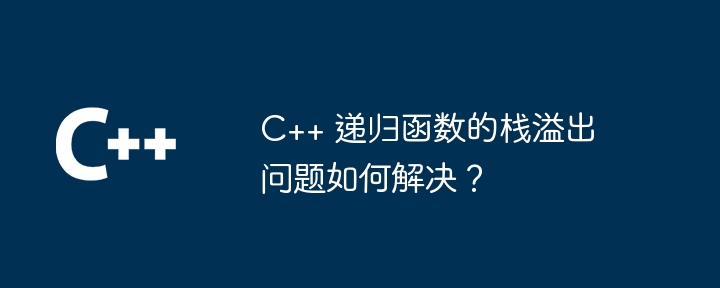
For the stack overflow problem of C recursive functions, the solutions include: reducing the recursion depth, reducing the stack frame size, and tail recursion optimization. For example, the Fibonacci sequence function can avoid stack overflow through tail recursion optimization.

Recursive functions create a new stack frame on the stack each time they are called. When the recursion depth is too large and the stack space is insufficient, a stack overflow will occur.
1. Reduce the recursion depth
2. Reduce the stack frame size
3. Tail recursion optimization
Consider the following Fibonacci sequence function:
// 尾递归版本 int fibonacci(int n) { return fibonacci_helper(n, 0, 1); } int fibonacci_helper(int n, int a, int b) { if (n == 0) return a; return fibonacci_helper(n-1, b, a+b); }
This is the tail-recursive version because the last function call recurses directly into itself. The compiler will optimize it to avoid stack overflow.
The following is the non-tail recursive version:
int fibonacci(int n) { if (n == 0) return 0; if (n == 1) return 1; return fibonacci(n-1) + fibonacci(n-2); }
For this non-tail recursive version, you can use tail recursive optimization techniques to convert it into a tail recursive version. For example, using auxiliary functions and swap operations:
int fibonacci(int n, int a = 0, int b = 1) { if (n == 0) return a; if (n == 1) return b; // 进行 swap 操作 std::swap(a, b); return fibonacci(n-1, b, a+b); }
By adopting tail recursion optimization or reducing the recursion depth, the stack overflow problem of recursive functions in C can be effectively solved.
The above is the detailed content of How to solve the stack overflow problem of C++ recursive functions?. For more information, please follow other related articles on the PHP Chinese website!
 What are the differences between c++ and c language
What are the differences between c++ and c language Recommended learning order for c++ and python
Recommended learning order for c++ and python Cost-effectiveness analysis of learning python and c++
Cost-effectiveness analysis of learning python and c++ Is c language the same as c++?
Is c language the same as c++? Which is better to learn first, c language or c++?
Which is better to learn first, c language or c++? The difference and connection between c language and c++
The difference and connection between c language and c++ C++ software Chinese change tutorial
C++ software Chinese change tutorial Cost-effectiveness analysis of learning python, java and c++
Cost-effectiveness analysis of learning python, java and c++



